INTRODUCTION
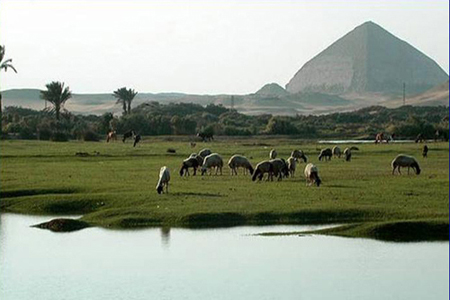
lush rural landscapes - seasonal marsh land and migrating birds - vast desert and
its raw beauty -overwhelming and enigmatic ancient monuments - traditional local
villages - ancient canals - the mighty Nile - lifestyle and traditional culture
of the resilient, friendly and committed people Dahshour is considered a region
with a great potential for tourism development. It is currently well-known for the
Red and Bent Pyramid(both constructed by Sneferu)and the Black Pyramid (of Amenmhat
III), but its rich natural and cultural heritage remains hidden. Dahshour has remained
hidden for years, indifferent to the passage of tourists who travel within established
international circuits close by, and almost untouched by modernization. At the same
time, the region of Dahshour holds a privileged location situated south of Cairo,
between the river Nile and the desert,comprising an integral section of the UNESCO
World Heritage Site. Many local community members still maintain old customs, and
live in a traditional way. Most of the population’s livelihoods are based on crops
and livestock farming. Dahshouroffers the opportunity to live unique and authentic
experiences based on farming lifestyles, and to learn about the history of an ancient
region.
Location
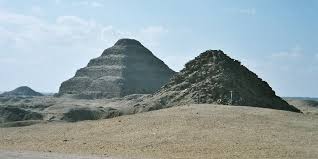
Dahshour,a cluster of five villages, is located within less than an hour’s travel
distance from Cairo (about 35 km),in the Giza Governorate,within easy reach by car
via the Maryoutea Canal Road. Dahshour covers an area of approximately 70 square
kilometres with roughly 40,000 inhabitants. The canal can be traced back in history
to the early days of MitRahina (Memphis) around 3,000 years ago and has provided
water to the agricultural activities in Nile Valley since then. Dahshour’s villages
include Manchiet Dahshour (with Berket(Lake ) seasonal wetland), Dahshour, Zawiet
Dahshour, ManchietKasseb, and Mazghona ,located directly on the left bank of the
Nile. It borders the desert near the Dahshour Archaeological Site and pyramids field
with other ancient relics.
The villages
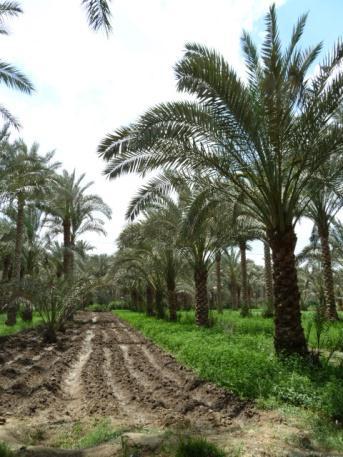
The village of Manchiet Dahshour is located immediately adjacent to the three unique
pyramids of Dahshour: the Bent, the Red and the Black Pyramid, which incidentally
form part of the Memphis Necropolis World Heritage Site located further north towards
Cairo.First opened to the public as late as 1996, the 3.5 km long pyramid field
contains 4th and 12thdynasty structures. The Bent Pyramid exhibits an early stage
of pyramid design, representing the evolutionary stage between the Step Pyramid
at Saqqara and the pyramids at Giza. The Red Pyramid is the world’s oldest true
pyramid, includes a 15m high burial chamber and is second in size only to Cheops
Pyramid in Giza. The ruins of the Black Pyramid demonstrate the internal construction
techniques used for centuries.The main commercial street runs west from the extended
village square towards the boundary of the village with community centre, shopping,
restaurants, bakeries, cafes, and additional service facilities. This is also the
street that presently is used for wedding processions and is therefore known as
a street of joy and celebration. The old core area of the village is the main cultural
asset and is invite for a historic, cultural tourist walk, passing by the old mosque,
the ‘holy man’ domed structures, the vernacular buildings and structures remaining,
old workshops and handicraft centres and other places worth a visit.
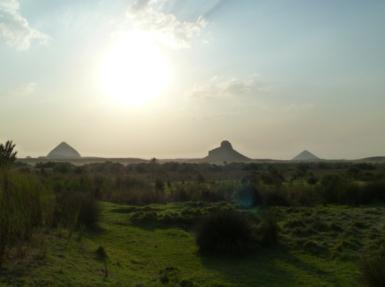
Berket Dahshour, located nearby Manchiet Dahshour, is a natural depression
and seasonal papyrus marshland visited in early spring and late autumn by myriad
migratory birds, and serves as one of the only such surviving ecosystems in Middle
Egypt. Berket Dahshour's relative seclusion, on the edge of the desert roughly 1
to 1.5 km away from the core of the old village, has resulted in this unique and
attractive seasonal wetland remaining intact and almost untouched by urban sprawl
or negatively impacted by tourists.The site’s appeal is enhanced by its location
on the fringe of attractive palm groves and at the edge of the Nile flood plain,
overlooked by the pyramids and offering the potential to attract both experienced
ornithologists as well as tourists with a general interest in natural and cultural
heritage.The village proper is populated by a tightly bound community with the potential
and declared desire to engage in organized social action and tourism. Moreover,
the area hosts a small resident community of distinguished artists, writers, photographers
and painters, whose skills can contribute actively to the enhancement of traditional
arts and crafts, improve income-generating activities and generally be an inspiration
for both villagers and visitors.
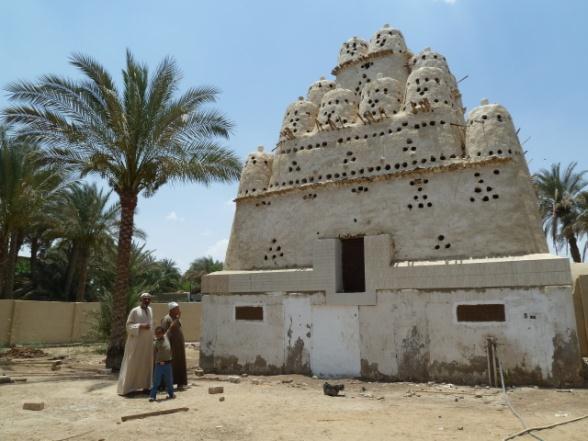
Dahshour and Zawiet villages are two individual villages, which over time
have grown and sprawled in all directions and now have almost grown together as
a continuous built environment from the Dahshour Zawiet and Maryoutea canals to
the Dahshour Canal and the desert.Dahshour and Dahshour Zawiet Villages combined
are the largest population concentration and the main service and commercial centre
in the Dahshour Rural Tourism Cluster. From the existing entry point to Dahshour
Village, the village access road connects directly to Mazghona and its railway station.There
is a narrow shopping street with traditional coffee shops and bakeries, and interesting
workshops including, among others, an informal palm frond joinery and basket weaving.
The palm frond production technique and the final products produced by the workshop
are today very basic and mostly for utilitarian use. However, the technique is at
the same time highly sophisticated. The old core areas of both Dahshour Village
and Zawiet Dahshour are worth exploring. Arrival to the twin villages on foot, bicycle
and horse to and from Berket Dahshour, Manchiet Dahshour and ManchietKasseb is mainly
along the Dahshour Canal.
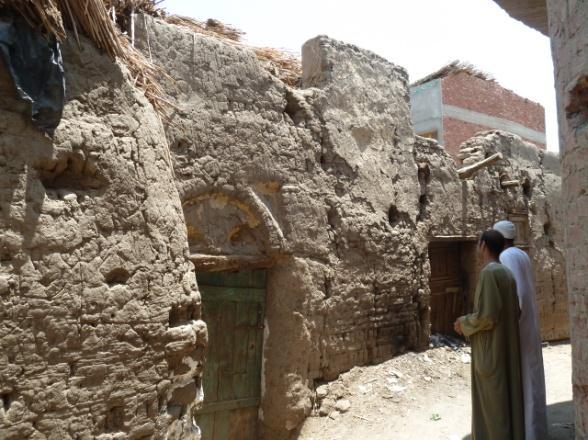
ManchietKasseb is the smallest of the formal villages in the Dahshour area.
It is easily reachable from the Maryoutea Canal by car to the perimeter of the village.
The village is unique in Dahshour in the sense that it is extremely distinct with
a clear transition from a dense ‘urban’ character village environment to an attractive
lush and abundant open agricultural landscape with almost no new development away
from the village core and no linear sprawl along roads and trails outside of the
well-defined village envelope. It gives a good impression of how villages must have
looked in the early days of farming in the fertile Nile Valley when protection against
common enemies, wild animals and the unknown was essential and many villages would
therefore be surrounded by walls with only few controlled entry points.ManchietKasseb
is the southern-most stop on the proposed Dahshour - Saqqara tourism circuit connecting
from the future Nile landing point in Mazghona to Saqqara along the Dahshour Canal,
the Desert, the Pyramid Field the Saqqara Archaeological site and back south to
Manchiet Dahshour. Thus, the circuit (approximately 36 km)is ideal for a 1 to 2
day bicycle trip, and a 2 to 4 day hike or horse-riding tour. Needless to say that
exploring the area can also be shortened or combined in many ways within the framework
of the 3 circuits or by people finding their own interesting routes along the way.It
is a very peaceful environment in the narrow streets of this small village. There
are a few shops and virtually no food and beverage outlets. There are, however,
a few interesting and very old houses or courtyards with traditional wooden doors
and gateways. The main attraction of ManchietKasseb is its pristine rural character
and tranquillity. At the end of almost every street running towards the perimeter
of the village, the eye meets the attractive green open farmland and the streets
and narrow lanes of the village turn into narrow attractive trails leading into
lush fields of corn and other cereal crops, vegetable patches or palm groves.
Mazghona village is attractively located between the River Nile and the ancient
Mazghona Canal, and with the core of the village being less than 2 km from the core
of Dahshour Village and therefore being almost ‘within walking distance’. Thus Mazghona
has the potential to become an important tourist transportation hub as the southern
‘hop on - hop off’ point of the Great Cairo Tourism Circuit. The core of the village
east of the canal is rather similar in nature to the other villages of Dahshour
,Mazghona’s role present a stopover and service centre along the north south free
rail road connecting Cairo with upper Egypt .
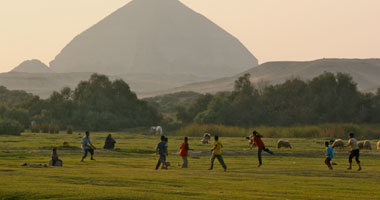
Routes within the villages
1. Walking tour through the village
Historical; cultural; community-based tourism Location: Manchiet; Zawiet - Dahshour;
Kasseb Visitors will take a community and village-based tour with stop-overs at
special points of interest, local food or drink outlets, bakeries and handicraft
shops.
2. Mountain Bike Tour (Desert and Palm tree fields)
Adventure; ecotourism; nature Location: All villages A two to three hours cycling
tour, passing through the dessert, palm trees fields, village streets and along
the canals. Mountain-bike parking spaces will be allocated at sightseeing points
along the route. Maps with marked routes will be provided to cyclists
3. Nile cruises north to Cairo City- Rural
nature Location: Magzhona; Cairo Cruises from Magzhona port to Cairo along the Nile,
relaxing trip to enjoy entertainment on the ship, or the view from a deck
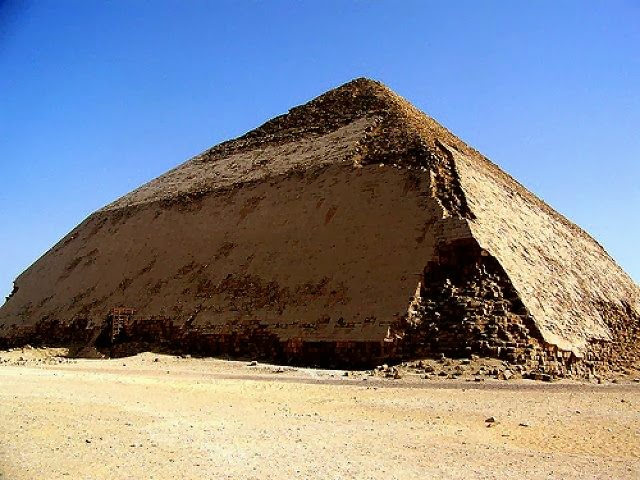
Getting there
The area is easily accessible by road (public microbus): The most convenient routes
are the two major road systems (north-south): the Maryoutea Canal Road and the Upper
Egypt Highway. A third road, to date unpaved, is the Dahshour Canal Road in north-south
direction. Furthermore, a railway station near Badrashin and one near Marazek serve
the area. The latter is called “Mazghona” (although being some 7.5 km north of Mazghona
Village). There is no direct waterborne transport to/from/ Cairo except the ‘Nile
Pharaoh’ steamer going up the Nile, suitable for transfer visitors coming from Cairo.
Visa regulations
Non-Egyptian visitors arriving in Egypt are required to be in possession of a valid
passport. Entry visas can be obtained from Egyptian Diplomatic and Consular Missions
Abroad or from the Entry Visa Department at the Travel Documents, Immigration and
Nationality Administration (TDINA). Alternatively, it is possible for most tourists
and visitors to obtain an entry visa at any of the major ports of entry. Please
check with your nearest Egyptian Consular mission for more details concerning visa
regulations applying to your citizenship. Details can also be obtained from the
official website of the Ministry of Foreign Affairs of the Arab Republic of Egypt
at: http://www.mfa.gov.eg/english/ConsularServices/Pages/ConsularServiceDetails.aspx?ID=Visa%20Application
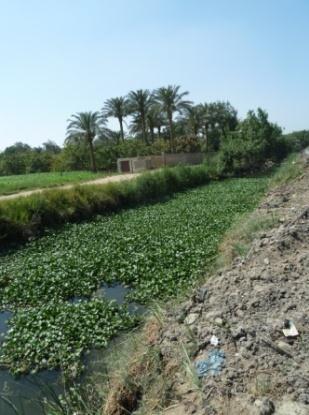
Accommodation
A large variety of accommodation is available in Cairo (35 km north), as well as
on the Maryoutea Canal Road (from Cairo to Dahshour).The closest hotel is about
20 km away from the villages. a small eco loge is available near the Berket seasonal
lake
Food and beverage
In the villages, a large number of cafés/small restaurants can be found, offering
traditional dishes of the local cuisine. Visitors should be aware that since tourism
development is in its very early stages, the hygiene and cleanliness standards might
not meet the expectations of all international travellers.
Communication
Egypt Post is the company responsible for postal services in Egypt. The telephone
code of Egypt is +20. There are five public phones in Mazghona and one in Manchiet
Money, exchange rates and other information
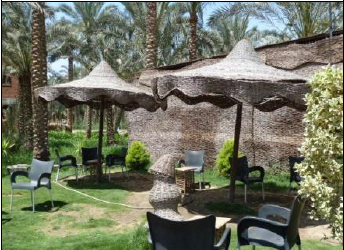
Egyptian Pound (EGP, locally: LE) is the national currency with bank notes of 200,
100, 50, 20, 10, 5 and 1 EGP, as well as 50 and 25 Piaster (100 Piaster = 1 EGP).There
are three ATMs in El Badrashein and one in Mazghona. On average, 1 USD is equivalent
to 6 EGP. VAT is 10 % in Egypt. Opening hours for businesses depend on the nature
of the business: Coffee shops usually open from 9 am until 2 am, restaurants and
retail businesses from 8 am to 9 pm, whereas other businesses such as car repair
shops, vocational shops, carpenters or electricians open from 10 am to 8 pm. The
electric current in Egypt is 220/240V/~50Hz and sockets are suitable for ground
plugs. Local time in Egypt is GMT +2 hours, no daylight saving time.
Holidays

Holidays that are widely celebrated, with government offices, public institutions
and ministries open:
January 1, New Year's Day
March 3, Sportsmen's day
March 19 , Taba Liberation Day
March 21, Mother's Day
June 18, Evacuation Day (Eid el-Galaa)
August 15, Flooding of the Nile (WafaaElnil)
October 24, Suez Day/Popular Resistance Day
December 23, Victory Day
Health information
There are overall five clinics in the area of Dahshour (5 in Dahshour, 3 in Manchiet,
3 in Mazghona), four health centres (one each in Dahshour, Zawiet Dahshour, Manchiet,
Mazghona), as well as two mother and childcare centres (one in Dahshour, one in
Mazghona).Many Pharmacies are available in all the villages ,some open 24 hours
/day
Dahshour mapping
The map has been developed in Google Maps and offers an overview of Dahshour region
by locating its communities and, in the background, the resources that include a
brief description and a picture. The map has been included in a draft website -
Dahshour Web Mapping - as an example for future developments and recommendations.
GIS Link:
Dahshour Web Mapping Link: